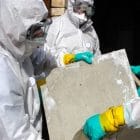What should you do if exposed to asbestos dust?
Being exposed to asbestos dust can put your health at serious risk and, if exposure occurs over a long period, can even be life threatening. Asbestos fibres can lodge in the lungs leading to lifelong health complications running anywhere from respiratory disease to cancer. If you’ve been exposed to asbestos fibres it’s important to immediately take action. Here’s our professional recommendations to safeguard your health, and the health of others, in the aftermath of asbestos exposure.
If you suspect that you have been exposed to asbestos dust, it’s important to take the following steps…
Limit further exposure
Once you know that asbestos fibres are in the atmosphere of your site, it’s important to immediately move to a well-ventilated area and ensure everyone in that environment does the same thing. Asbestos fibres might have also made their way onto your skin and clothing, so remove all contaminated clothing as soon as possible, seal them in an airtight bag or container and prevent any further spread. It’s also worth showering if available.
Do not shake or vacuum clothing
Dusting off your clothing will only send more dust and fibres into the atmosphere, causing greater spread and risk to you and others. Do not shake, dust off or vacuum contaminated clothing or other materials. Handle these items with great care and keep them carefully away until professional asbestos removers arrive. They will be able to safely and legally dispose of the contaminated materials.
Avoid touching your face or eating/drinking
Asbestos fibres can settle on your skin or objects around you. Avoid touching your face to prevent ingestion or inhalation of the fibres. Refrain from eating or drinking until you have washed your hands and face thoroughly.
Can you wash asbestos off hands
Wash your hands and face with mild soap and water to remove any asbestos fibres. Use a wet cloth or wet mop to clean any surfaces that may have come into contact with the dust. Do not use a dusting brush, as this can disturb the fibres. It’s important to thoroughly clean the shower or basin after you’ve washed off fibres, and it’s a good idea to have asbestos testing throughout all areas where contamination may have occurred.
Seek medical advice
This is the most important step to take. Consult a healthcare professional, preferably a specialist in asbestos, to evaluate the level of exposure and discuss appropriate next steps. It’s important to inform the healthcare provider about the potential asbestos exposure so that they can monitor your health accordingly and provide personalised guidance based on your specific situation and the extent of exposure.
Keep track of your exposure
Document the date, time, location, and duration of the exposure, as well as any symptoms you may experience. This information will be valuable when discussing your situation with healthcare professionals.
Follow legal requirements
Depending on your jurisdiction, there may be specific reporting and notification requirements for asbestos exposure. Make sure to comply with any applicable regulations and inform the appropriate authorities if necessary.
Avoid exposure by enlisting professional asbestos removal and disposal. Contact Ryno’s today if you are aware of or suspect the presence of asbestos before exposure to asbestos dust occurs.






